GOSAT CH4 Vertical Profiles over the Indian Subcontinent: Effect of a Priori and Averaging Kernels for Climate Applications
Abstract
1. Introduction
2. Methods
2.1. Study Domain
2.2. GOSAT-TIR Retrievals
2.3. TIR CH4 Profile Properties
2.4. MIROC4-ACTM Simulations
2.5. Data Processing
2.6. AK Functions and the Retrieval Sensitivity
2.7. The Prophet Analysis and Forecasting Model
3. Results
3.1. Prevailing Atmospheric Conditions over the Indian Subcontinent
3.2. CH4 over India Observed by GOSAT-TIR and Simulated by MIROC4-ACTM
3.3. CH4 Vertical Profiles
3.4. CH4 Time–Altitude Variation
3.5. Seasonal Variation of CH4
3.6. Regional CH4 Emission Estimation
3.7. Comparison with Ground Observations
4. Discussion
5. Conclusions
Supplementary Materials
Author Contributions
Funding
Data Availability Statement
Acknowledgments
Conflicts of Interest
References
- Patra, P.K.; Canadell, J.G.; Houghton, R.A.; Piao, S.L.; Oh, N.-H.; Ciais, P.; Manjunath, K.R.; Chhabra, A.; Wang, T.; Bhattacharya, T.; et al. The carbon budget of South Asia. Biogeosciences 2013, 10, 513–527. [Google Scholar] [CrossRef]
- Akimoto, H. Global Air Quality and Pollution. Science 2003, 302, 1716–1719. [Google Scholar] [CrossRef] [PubMed]
- Ohara, T.; Akimoto, H.; Kurokawa, J.; Horii, N.; Yamaji, K.; Yan, X.; Hayasaka, T. An Asian emission inventory of anthropogenic emission sources for the period 1980–2020. Atmos. Chem. Phys. 2007, 7, 4419–4444. [Google Scholar] [CrossRef]
- Janssens-Maenhout, G.; Crippa, M.; Guizzardi, D.; Muntean, M.; Schaaf, E.; Dentener, F.; Bergamaschi, P.; Pagliari, V.; Olivier, J.G.J.; Peters, J.A.H.W.; et al. EDGAR v4.3.2 Global Atlas of the three major greenhouse gas emissions for the period 1970–2012. Earth Syst. Sci. Data 2019, 11, 959–1002. [Google Scholar] [CrossRef]
- Kar, J.; Deeter, M.N.; Fishman, J.; Liu, Z.; Omar, A.; Creilson, J.K.; Trepte, C.R.; Vaughan, M.A.; Winker, D.M. Wintertime pollution over the Eastern Indo-Gangetic Plains as observed from MOPITT, CALIPSO and tropospheric ozone residual data. Atmos. Chem. Phys. 2010, 10, 12273–12283. [Google Scholar] [CrossRef]
- Ganesan, A.L.; Rigby, M.; Lunt, M.F.; Parker, R.J.; Boesch, H.; Goulding, N.; Umezawa, T.; Zahn, A.; Chatterjee, A.; Prinn, R.G.; et al. Atmospheric observations show accurate reporting and little growth in India’s methane emissions. Nat. Commun. 2017, 8, 1–7. [Google Scholar] [CrossRef]
- Guha, T.; Tiwari, Y.K.; Valsala, V.; Lin, X.; Ramonet, M.; Mahajan, A.; Datye, A.; Kumar, K.R. What controls the atmospheric methane seasonal variability over India? Atmos. Environ. 2018, 175, 83–91. [Google Scholar] [CrossRef]
- Chandra, N.; Hayashida, S.; Saeki, T.; Patra, P.K. What controls the seasonal cycle of columnar methane observed by GOSAT over different regions in India? Atmos. Chem. Phys. 2017, 17, 12633–12643. [Google Scholar] [CrossRef]
- Lin, X.; Ciais, P.; Bousquet, P.; Ramonet, M.; Yin, Y.; Balkanski, Y.; Cozic, A.; Delmotte, M.; Evangeliou, N.; Indira, N.K.; et al. Simulating CH4 and CO2 over South and East Asia using the zoomed chemistry transport model LMDz-INCA. Atmos. Chem. Phys. 2018, 18, 9475–9497. [Google Scholar] [CrossRef]
- Webster, P.J.; Magaña, V.O.; Palmer, T.N.; Shukla, J.; Tomas, R.A.; Yanai, M.; Yasunari, T. Monsoons: Processes, predictability, and the prospects for prediction. J. Geophys. Res. Ocean. 1998, 103, 14451–14510. [Google Scholar] [CrossRef]
- Fleitmann, D.; Burns, S.J.; Mangini, A.; Mudelsee, M.; Kramers, J.; Villa, I.; Neff, U.; Al-Subbary, A.A.; Buettner, A.; Hippler, D.; et al. Holocene ITCZ and Indian monsoon dynamics recorded in stalagmites from Oman and Yemen (Socotra). Quat. Sci. Rev. 2007, 26, 170–188. [Google Scholar] [CrossRef]
- Fu, R.; Hu, Y.; Wright, J.S.; Jiang, J.H.; Dickinson, R.E.; Chen, M.; Filipiak, M.; Read, W.G.; Waters, J.W.; Wu, D.L. Short circuit of water vapor and polluted air to the global stratosphere by convective transport over the Tibetan Plateau. Proc. Natl. Acad. Sci. USA 2006, 103, 5664–5669. [Google Scholar] [CrossRef]
- Randel, W.J.; Park, M.; Emmons, L.; Kinnison, D.; Bernath, P.; Walker, K.A.; Boone, C.; Pumphrey, H. Asian monsoon transport of pollution to the stratosphere. Science 2010, 328, 611–613. [Google Scholar] [CrossRef]
- Randel, W.J.; Park, M. Deep convective influence on the Asian summer monsoon anticyclone and associated tracer variability observed with Atmospheric Infrared Sounder (AIRS). J. Geophys. Res. Atmos. 2006, 111, 1–13. [Google Scholar] [CrossRef]
- Xiong, X.; Houweling, S.; Wei, J.; Maddy, E.; Sun, F.; Barnet, C. Methane plume over south Asia during the monsoon season: Satellite observation and model simulation. Atmos. Chem. Phys. 2009, 9, 783–794. [Google Scholar] [CrossRef]
- Garny, H.; Randel, W.J. Transport pathways from the Asian monsoon anticyclone to the stratosphere. Atmos. Chem. Phys. 2016, 16, 2703–2718. [Google Scholar] [CrossRef]
- Park, M.; Randel, W.J.; Kinnison, D.E.; Garcia, R.R.; Choi, W. Seasonal variation of methane, water vapor, and nitrogen oxides near the tropopause: Satellite observations and model simulations. J. Geophys. Res. Atmos. 2004. [Google Scholar] [CrossRef]
- Park, M.; Randel, W.J.; Emmons, L.K.; Bernath, P.F.; Walker, K.A.; Boone, C.D. Chemical isolation in the Asian monsoon anticyclone observed in Atmospheric Chemistry Experiment (ACE-FTS) data. Atmos. Chem. Phys. 2008, 8, 757–764. [Google Scholar] [CrossRef]
- Butz, A.; Hasekamp, O.P.; Frankenberg, C.; Vidot, J.; Aben, I. CH4 retrievals from space-based solar backscatter measurements: Performance evaluation against simulated aerosol and cirrus loaded scenes. J. Geophys. Res. Atmos. 2010. [Google Scholar] [CrossRef]
- Parker, R.; Boesch, H.; Cogan, A.; Fraser, A.; Feng, L.; Palmer, P.I.; Messerschmidt, J.; Deutscher, N.; Griffith, D.W.T.; Notholt, J.; et al. Methane observations from the Greenhouse Gases Observing SATellite: Comparison to ground-based TCCON data and model calculations. Geophys. Res. Lett. 2011, 38. [Google Scholar] [CrossRef]
- Yoshida, Y.; Kikuchi, N.; Morino, I.; Uchino, O.; Oshchepkov, S.; Bril, A.; Saeki, T.; Schutgens, N.; Toon, G.C.; Wunch, D.; et al. Improvement of the retrieval algorithm for GOSAT SWIR XCO2 and XCH4 and their validation using TCCON data. Atmos. Meas. Tech. Discuss. 2013, 6, 949–988. [Google Scholar]
- Saitoh, N.; Kimoto, S.; Sugimura, R.; Imasu, R.; Kawakami, S.; Shiomi, K.; Kuze, A.; Machida, T.; Sawa, Y.; Matsueda, H. Algorithm update of the GOSAT/TANSO-FTS thermal infrared CO2 product (version 1) and validation of the UTLS CO2 data using CONTRAIL measurements. Atmos. Meas. Tech. 2016, 9, 2119–2134. [Google Scholar] [CrossRef]
- De Lange, A.; Landgraf, J. Methane profiles from GOSAT thermal infrared spectra. Atmos. Meas. Tech. 2018, 11, 3815–3828. [Google Scholar] [CrossRef]
- Ricaud, P.; Sic, B.; El Amraoui, L.; Attié, J.L.; Zbinden, R.; Huszar, P.; Szopa, S.; Parmentier, J.; Jaidan, N.; Michou, M.; et al. Impact of the Asian monsoon anticyclone on the variability of mid-to-upper tropospheric methane above the Mediterranean Basin. Atmos. Chem. Phys. 2014, 14, 11427–11446. [Google Scholar] [CrossRef]
- Rodgers, C.D. Inverse Methods for Atmospheric Sounding: Theory and Practice, Series on Atmospheric, Oceanic and Planetary Physics—Volume 2; World Scientific Publishing: Singapore, 2000. [Google Scholar]
- Cooper, M.; Martin, R.; Henze, D.; Jones, D. Effects of a priori profile shape assumptions oncomparisons between satellite NO2 columns and model simulations. Atmos. Chem. Phys. 2020, 20, 7231–7241. [Google Scholar] [CrossRef]
- Yokota, T.; Yoshida, Y.; Eguchi, N.; Ota, Y.; Tanaka, T.; Watanabe, H.; Maksyutov, S. Global concentrations of CO2 and CH4 retrieved from GOSAT: First preliminary results. Sci. Online Lett. Atmos. 2009. [Google Scholar] [CrossRef]
- Kuze, A.; Suto, H.; Nakajima, M.; Hamazaki, T. Thermal and near infrared sensor for carbon observation Fourier-transform spectrometer on the Greenhouse Gases Observing Satellite for greenhouse gases monitoring. Appl. Opt. 2009, 48, 6716–6733. [Google Scholar] [CrossRef] [PubMed]
- Kuze, A.; Suto, H.; Shiomi, K.; Urabe, T.; Nakajima, M.; Yoshida, J.; Kawashima, T.; Yamamoto, Y.; Kataoka, F.; Buijs, H. Level 1 algorithms for TANSO on GOSAT: Processing and on-orbit calibrations. Atmos. Meas. Tech. 2012. [Google Scholar] [CrossRef]
- Saitoh, N.; Touno, M.; Hayashida, S.; Imasu, R.; Shiomi, K.; Yokota, T.; Yoshida, Y.; Machida, T.; Matsueda, H.; Sawa, Y. Comparisons between XCH4 from GOSAT Shortwave and Thermal Infrared Spectra and Aircraft CH4 Measurements over Guam. Sola 2012, 8, 145–149. [Google Scholar] [CrossRef]
- Holl, G.; Walker, K.A.; Conway, S.; Saitoh, N.; Boone, C.D.; Strong, K.; Drummond, J.R. Methane cross-validation between three Fourier transform spectrometers: SCISAT ACE-FTS, GOSAT TANSO-FTS, and ground-based FTS measurements in the Canadian high Arctic. Atmos. Meas. Tech. 2016, 9, 1961–1980. [Google Scholar] [CrossRef]
- Zou, M.; Xiong, X.; Saitoh, N.; Warner, J.; Zhang, Y.; Chen, L.; Weng, F.; Fan, M. Satellite observation of atmospheric methane: Intercomparison between AIRS and GOSAT TANSO-FTS retrievals. Atmos. Meas. Tech. 2016, 9, 3567–3576. [Google Scholar] [CrossRef]
- Olsen, K.S.; Strong, K.; Walker, K.A.; Boone, C.D.; Raspollini, P.; Plieninger, J.; Bader, W.; Conway, S.; Grutter, M.; Hannigan, J.W.; et al. Comparison of the GOSAT TANSO-FTS TIR CH volume mixing ratio vertical profiles with those measured by ACE-FTS, ESA MIPAS, IMK-IAA MIPAS, and 16 NDACC stations. Atmos. Meas. Tech. 2017, 10, 3697–3718. [Google Scholar] [CrossRef]
- Saeki, T.; Saito, R.; Belikov, D.; Maksyutov, S. Global high-resolution simulations of CO2 and CH4 using a NIES transport model to produce a priori concentrations for use in satellite data retrievals. Geosci. Model Dev. 2013, 6, 81–100. [Google Scholar] [CrossRef]
- Watanabe, S.; Miura, H.; Sekiguchi, M.; Nagashima, T.; Sudo, K.; Emori, S.; Kawamiya, M. Development of an Atmospheric General Circulation Model for Integrated Earth System Modeling on the Earth Simulator. J. Earth Simulator 2008, 9, 27–35. [Google Scholar]
- Patra, P.K.; Takigawa, M.; Watanabe, S.; Chandra, N.; Ishijima, K.; Yamashita, Y. Improved chemical tracer simulation by MIROC4.0-based atmospheric chemistry-transport model (MIROC4-ACTM). Sci. Online Lett. Atmos. 2018. [Google Scholar] [CrossRef]
- Kobayashi, S.; Ota, Y.; Harada, Y.; Ebita, A.; Moriya, M.; Onoda, H.; Onogi, K.; Kamahori, H.; Kobayashi, C.; Endo, H.; et al. The JRA-55 reanalysis: General specifications and basic characteristics. J. Meteorol. Soc. Jpn. 2015, 93, 5–48. [Google Scholar] [CrossRef]
- Spivakovsky, C.M.; Logan, J.A.; Montzka, S.A.; Balkanski, Y.J.; Foreman-Fowler, M.; Jones, D.B.A.; Horowitz, L.W.; Fusco, A.C.; Brenninkmeijer, C.A.M.; Prather, M.J.; et al. Three-dimensional climatological distribution of tropospheric OH: Update and evaluation. J. Geophys. Res. Atmos. 2000. [Google Scholar] [CrossRef]
- Patra, P.K.; Krol, M.C.; Montzka, S.A.; Arnold, T.; Atlas, E.L.; Lintner, B.R.; Stephens, B.B.; Xiang, B.; Elkins, J.W.; Fraser, P.J.; et al. Observational evidence for interhemispheric hydroxyl-radical parity. Nature 2014, 513, 219–223. [Google Scholar] [CrossRef]
- Chandra, N.; Patra, P.K.; Bisht, J.S.H.; Ito, A.; Morimoto, S.; Janssens-Maenhout, G.; Umezawa, T.; Fujita, R.; Takigawa, M.; Watanabe, S.; et al. Emissions from the oil and gas sectors, coal mining and ruminant farming drive methane growth over the past three decades. J Meteorol. Soc. Jpn. 2021. [Google Scholar] [CrossRef]
- Cao, M.; Marshall, S.; Gregson, K. Global carbon exchange and methane emissions from natural wetlands: Application of a process-based model. J. Geophys. Res. Atmos. 1996. [Google Scholar] [CrossRef]
- Walter, B.P.; Heimann, M.; Matthews, E. Modeling modern methane emissions from natural wetlands Model description and results. J. Geophys. Res. Atmos. 2001. [Google Scholar] [CrossRef]
- Van Der Werf, G.R.; Randerson, J.T.; Giglio, L.; Van Leeuwen, T.T.; Chen, Y.; Rogers, B.M.; Mu, M.; Van Marle, M.J.E.; Morton, D.C.; Collatz, G.J.; et al. Global fire emissions estimates during 1997–2016. Earth Syst. Sci. Data 2017, 9, 697–720. [Google Scholar] [CrossRef]
- Patra, P.K.; Houweling, S.; Krol, M.; Bousquet, P.; Belikov, D.; Bergmann, D.; Bian, H.; Cameron-Smith, P.; Chipperfield, M.P.; Corbin, K.; et al. TransCom model simulations of CH4 and related species: Linking transport, surface flux and chemical loss with CH4 variability in the troposphere and lower stratosphere. Atmos. Chem. Phys. 2011, 11, 12813–12837. [Google Scholar] [CrossRef]
- Ito, A.; Tohjima, Y.; Saito, T.; Umezawa, T.; Hajima, T.; Hirata, R.; Saito, M.; Terao, Y. Methane budget of East Asia, 1990–2015: A bottom-up evaluation. Sci. Total Environ. 2019, 676, 40–52. [Google Scholar] [CrossRef]
- Ito, A. Methane emission from pan-Arctic natural wetlands estimated using a process-based model, 1901–2016. Polar Sci. 2019, 21, 26–36. [Google Scholar] [CrossRef]
- Taylor, S.J.; Letham, B. Forecasting at Scale. Am. Stat. 2018. [Google Scholar] [CrossRef]
- Belikov, D.; Arshinov, M.; Belan, B.; Davydov, D.; Fofonov, A.; Sasakawa, M.; Machida, T. Analysis of the diurnal, weekly, and seasonal cycles and annual trends in atmospheric CO2 and CH4 at tower network in Siberia from 2005 to 2016. Atmosphere 2019, 10, 689. [Google Scholar] [CrossRef]
- Findlater, J. A major low-level air current near the Indian Ocean during the northern summer. Q. J. R. Meteorol. Soc. 1969. [Google Scholar] [CrossRef]
- Metya, A.; Datye, A.; Chakraborty, S.; Tiwari, Y.K.; Sarma, D.; Bora, A.; Gogoi, N. Diurnal and seasonal variability of CO2 and CH4 concentration in a semi-urban environment of western India. Sci. Rep. 2021, 11, 2931. [Google Scholar] [CrossRef]
- Devasthale, A.; Fueglistaler, S. A climatological perspective of deep convection penetrating the TTL during the Indian summer monsoon from the AVHRR and MODIS instruments. Atmos. Chem. Phys. 2010, 10, 4573–4582. [Google Scholar] [CrossRef]
- Bergman, J.W.; Fierli, F.; Jensen, E.J.; Honomichl, S.; Pan, L.L. Boundary layer sources for the asian anticyclone: Regional contributions to a vertical conduit. J. Geophys. Res. Atmos. 2013, 118, 2560–2575. [Google Scholar] [CrossRef]
- Olivier, J.G.J.; Berdowski, J.J.M. Global Emissions Sources and Sinks. In The Climate System; A.A. Balkema Publishers/Swets and Zeitlinger Publishers: Lisse, The Netherlands, 2001; pp. 33–78. [Google Scholar]
- Fung, I. Three-dimensional model synthesis of the global methane cycle. J. Geophys. Res. 1991. [Google Scholar] [CrossRef]
- Belikov, D.A.; Maksyutov, S.; Krol, M.; Fraser, A.; Rigby, M.; Bian, H.; Agusti-Panareda, A.; Bergmann, D.; Bousquet, P.; Cameron-Smith, P.; et al. Off-line algorithm for calculation of vertical tracer transport in the troposphere due to deep convection. Atmos. Chem. Phys. 2013, 13, 1093–1114. [Google Scholar] [CrossRef]
- Saito, R.; Patra, P.K.; Sweeney, C.; Machida, T.; Krol, M.; Houweling, S.; Bousquet, P.; Agusti-Panareda, A.; Belikov, D.; Bergmann, D.; et al. TransCom model simulations of methane: Comparison of vertical profiles with aircraft measurements. J. Geophys. Res. Atmos. 2013, 118, 3891–3904. [Google Scholar] [CrossRef]
- Krishnamurti, T.N.; Ardanuy, P. The 10- to 20-day westward propagating mode and ‘Breaks in the Monsoons’. Tellus 1980. [Google Scholar] [CrossRef]
- Tiwari, Y.K.; Guha, T.; Valsala, V.; Lopez, A.S.; Cuevas, C.; Fernandez, R.P.; Mahajan, A.S. Understanding atmospheric methane sub-seasonal variability over India. Atmos. Environ. 2020, 223, 117206. [Google Scholar] [CrossRef]
- Dey, S.; Di Girolamo, L. A climatology of aerosol optical and microphysical properties over the Indian subcontinent from 9 years (2000–2008) of Multiangle Imaging Spectroradiometer (MISR) data. J. Geophys. Res. Atmos. 2010, 115, 1–22. [Google Scholar] [CrossRef]
- Kavitha, M.; Nair, P.R.; Girach, I.A.; Aneesh, S.; Sijikumar, S.; Renju, R. Diurnal and seasonal variations in surface methane at a tropical coastal station: Role of mesoscale meteorology. Sci. Total Environ. 2018, 631–632, 1472–1485. [Google Scholar] [CrossRef]
- Kavitha, M.; Nair, P.R. Satellite-retrieved vertical profiles of methane over the Indian region: Impact of synoptic-scale meteorology. Int. J. Remote Sens. 2019, 40, 5585–5616. [Google Scholar] [CrossRef]
- Saunois, M.R.; Stavert, A.; Poulter, B.; Bousquet, P.G.; Canadell, J.B.; Jackson, R.A.; Raymond, P.J.; Dlugokencky, E.; Houweling, S.K.; Patra, P.; et al. The global methane budget 2000–2017. Earth Syst. Sci. Data 2020, 12, 1561–1623. [Google Scholar] [CrossRef]
- Patra, P.K.; Saeki, T.; Dlugokencky, E.J.; Ishijima, K.; Umezawa, T.; Ito, A.; Aoki, S.; Morimoto, S.; Kort, E.A.; Crotwell, A.; et al. Regional methane emission estimation based on observed atmospheric concentrations (2002–2012). J. Meteorol. Soc. Jpn. 2016, 94, 91–113. [Google Scholar] [CrossRef]
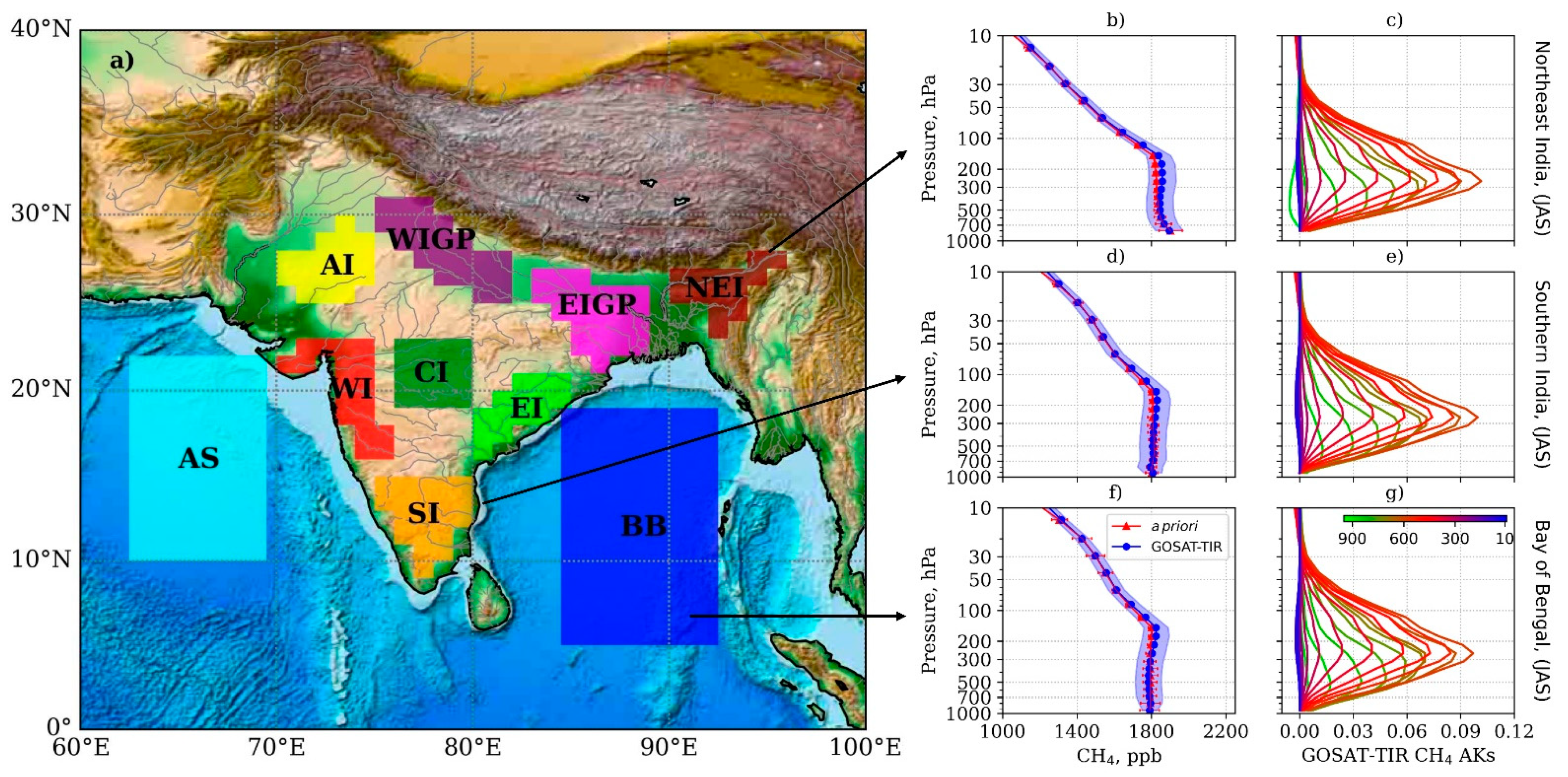
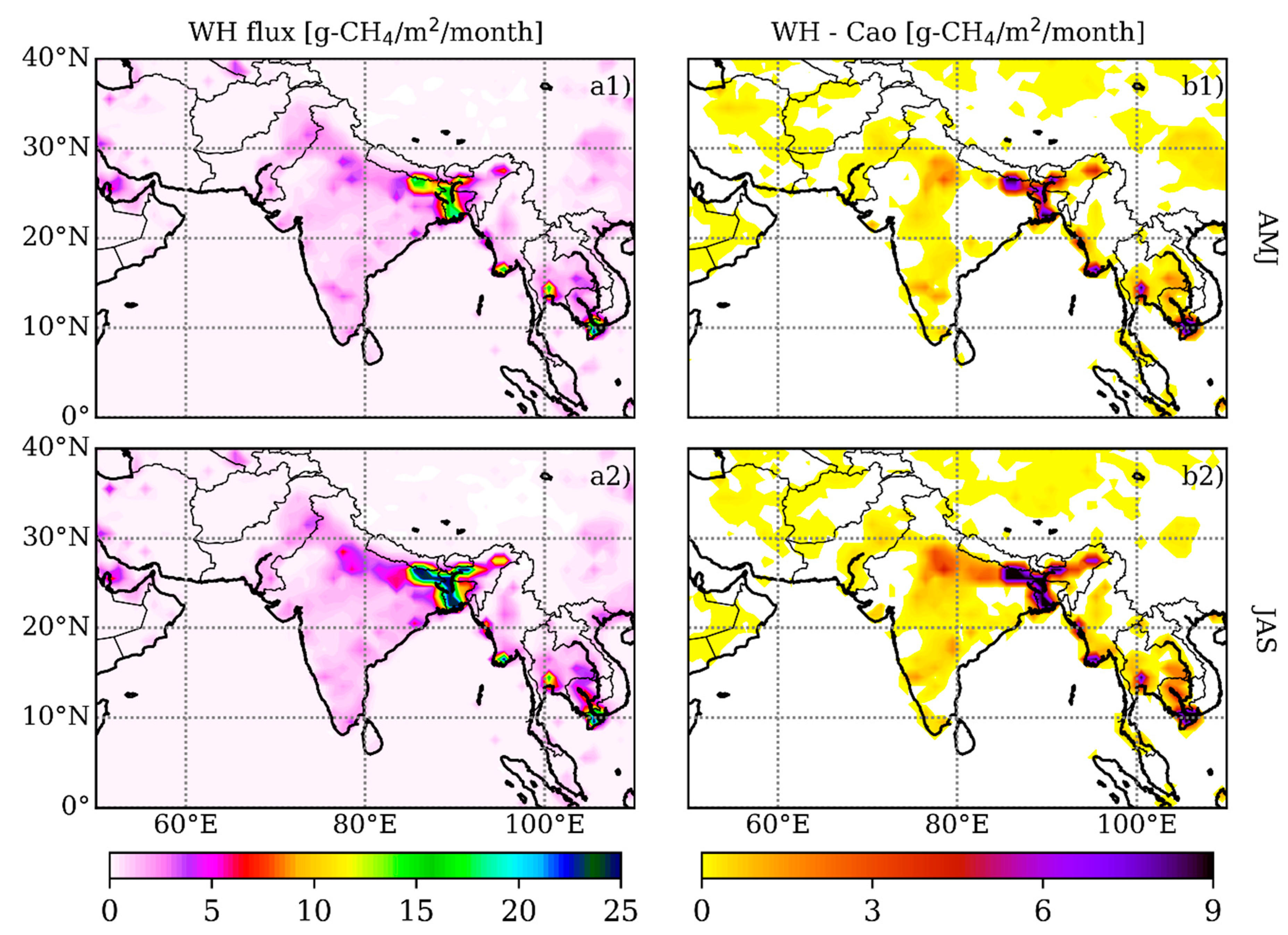
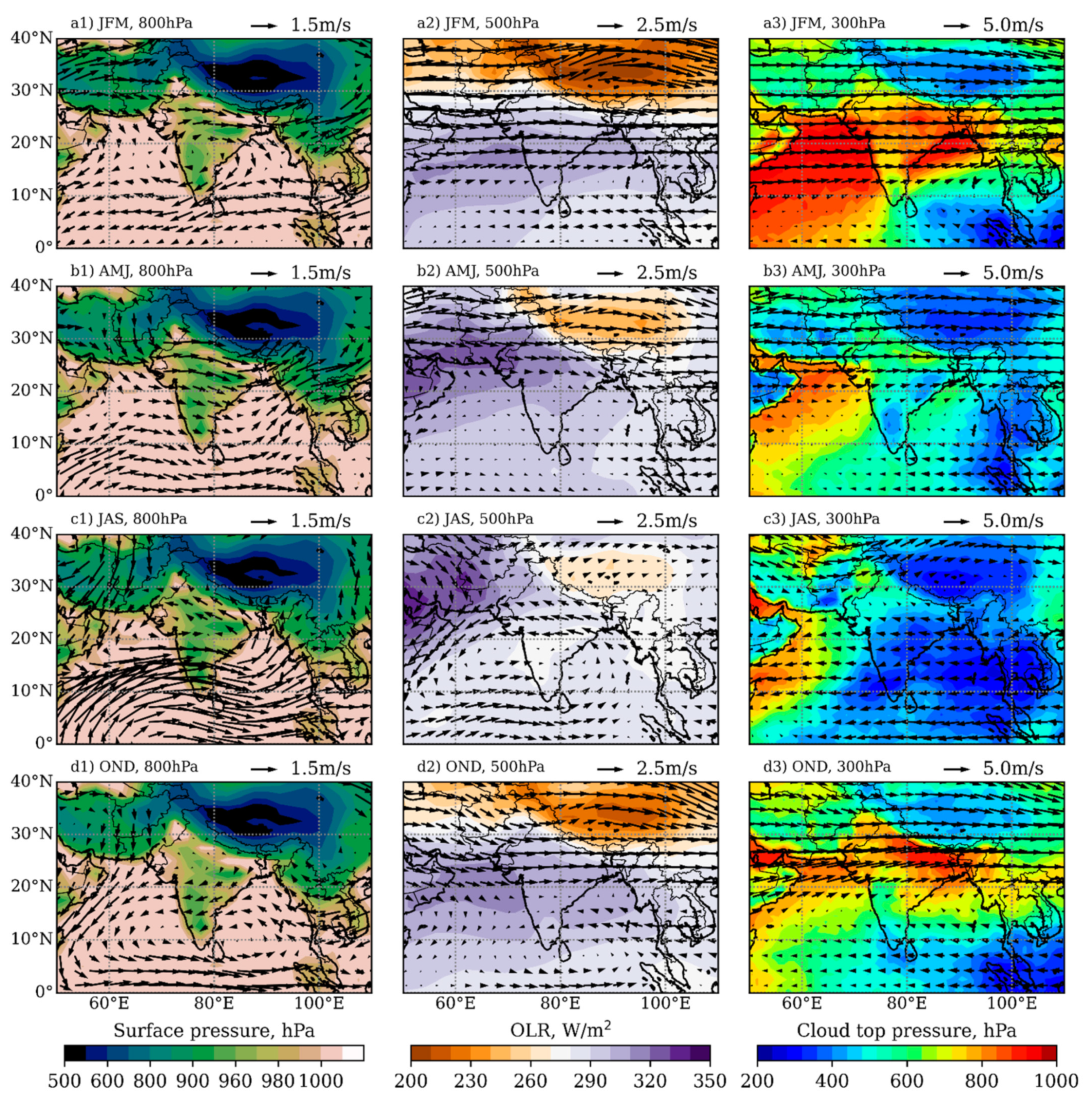
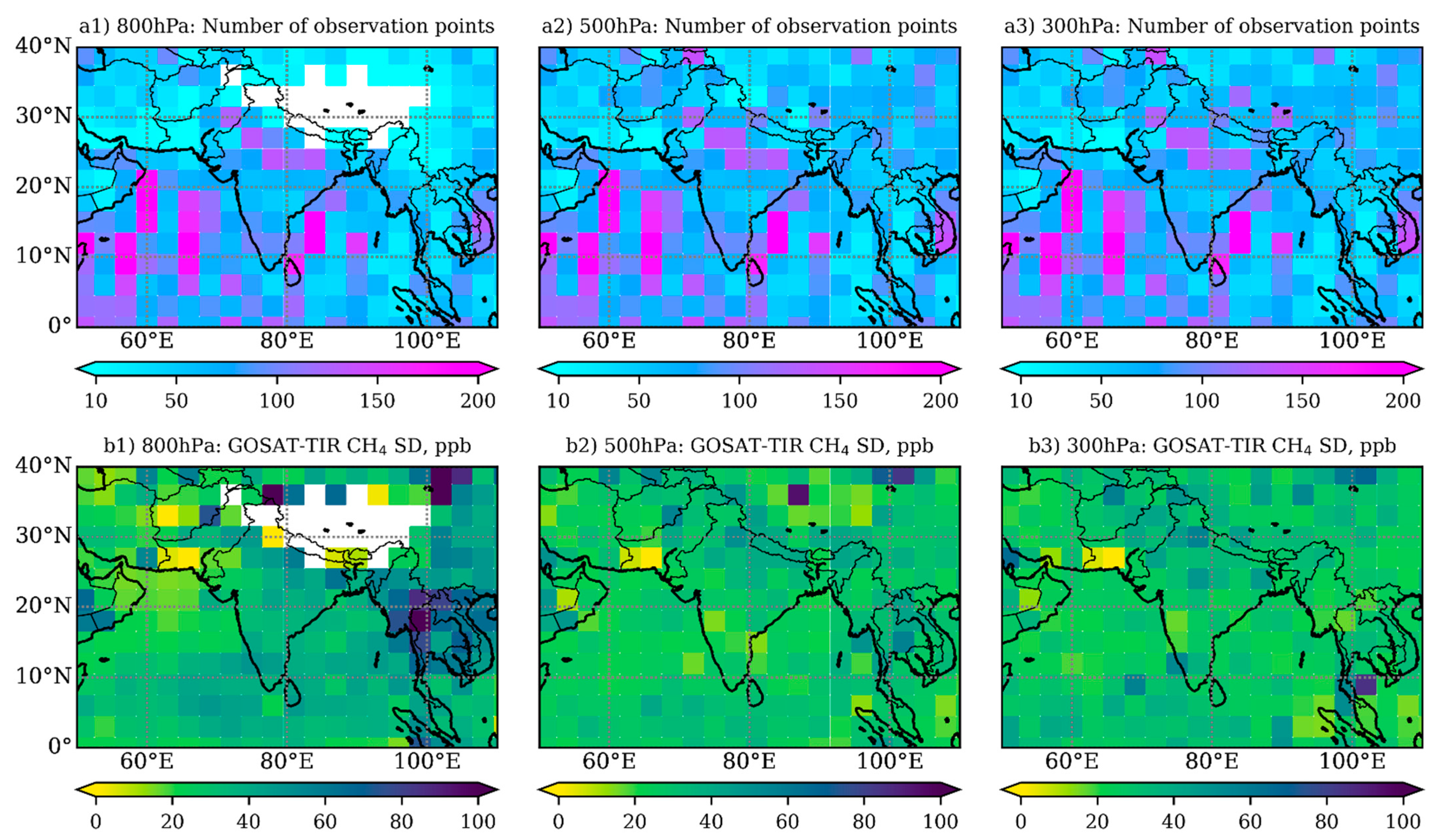

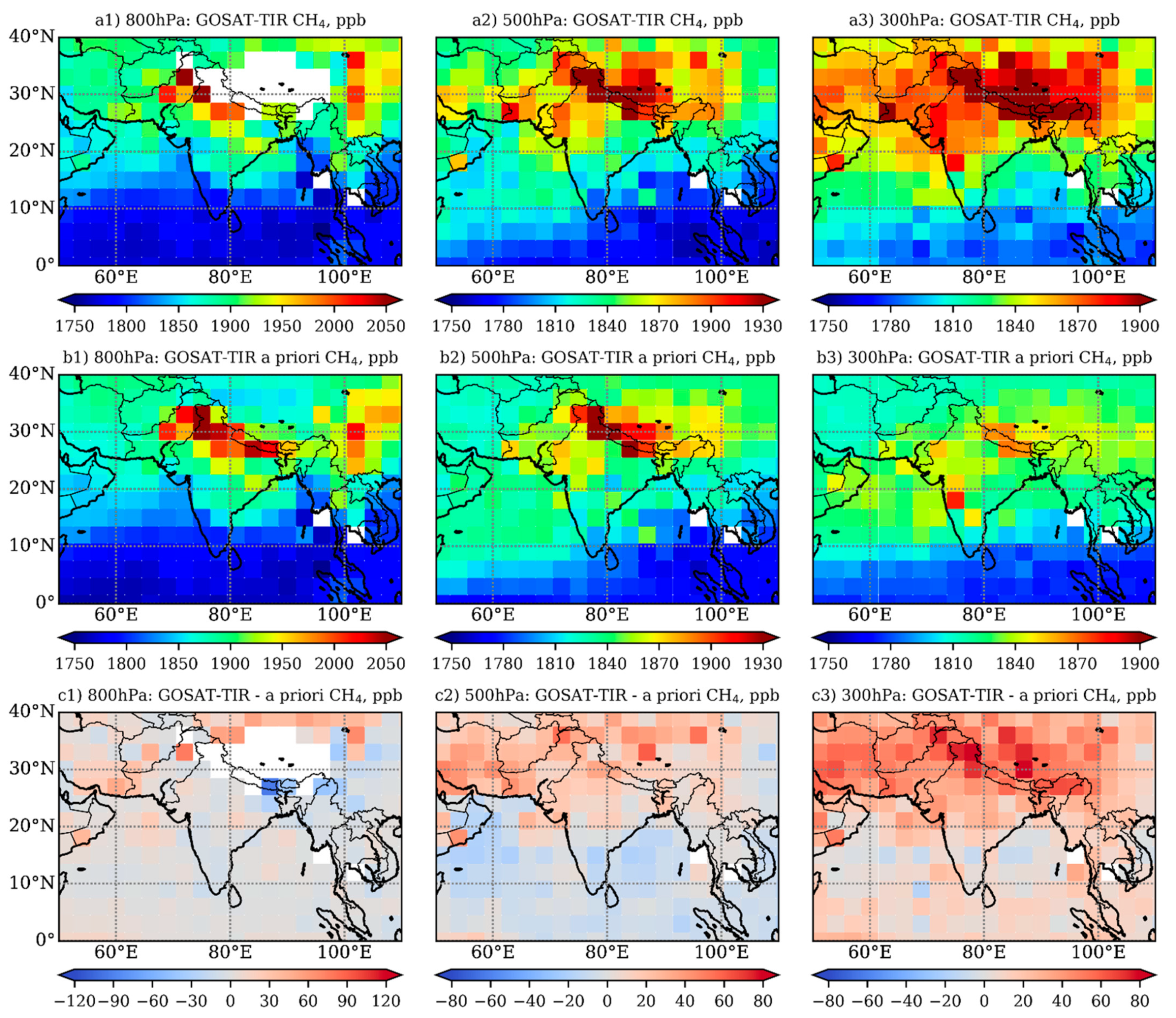

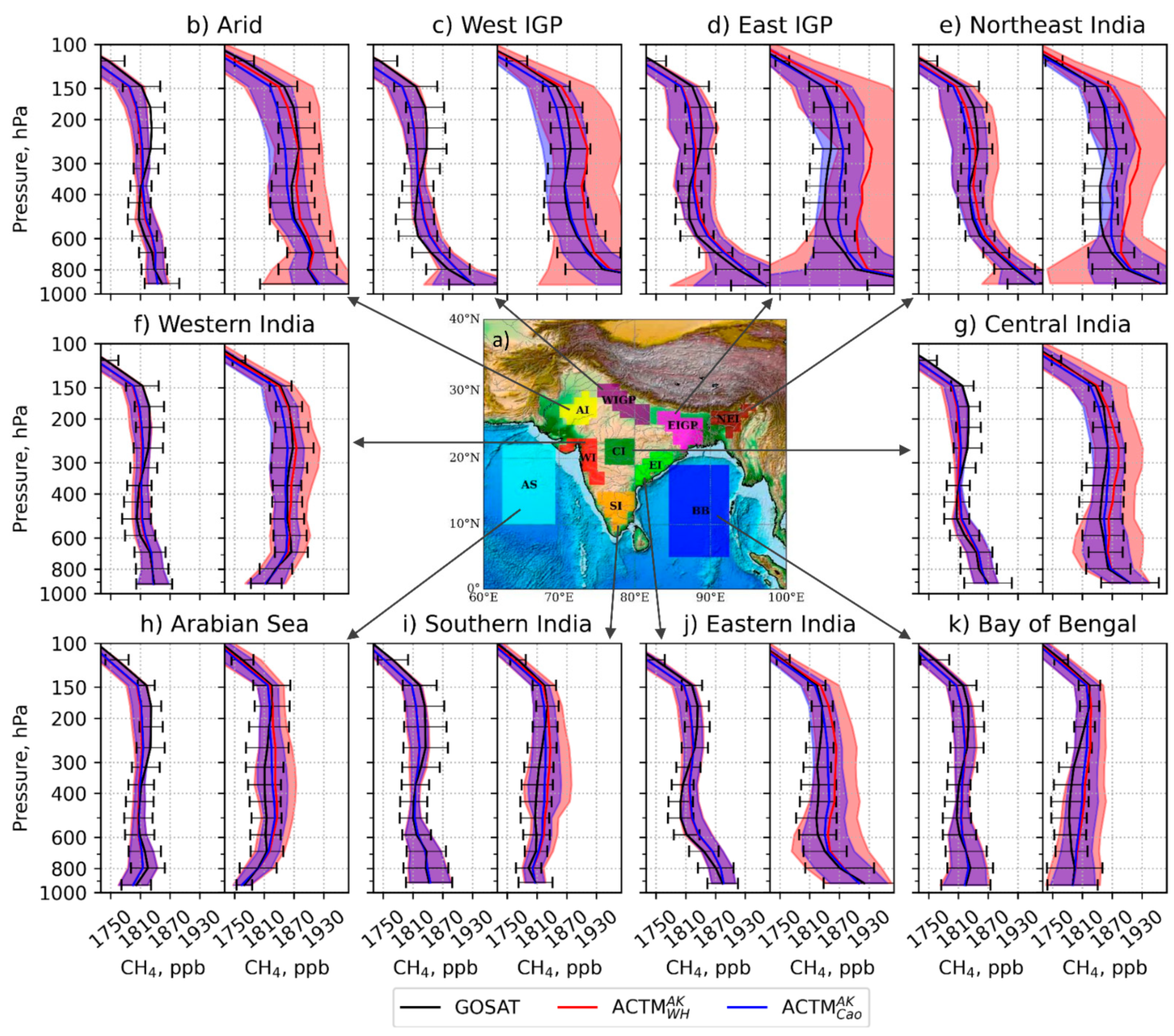
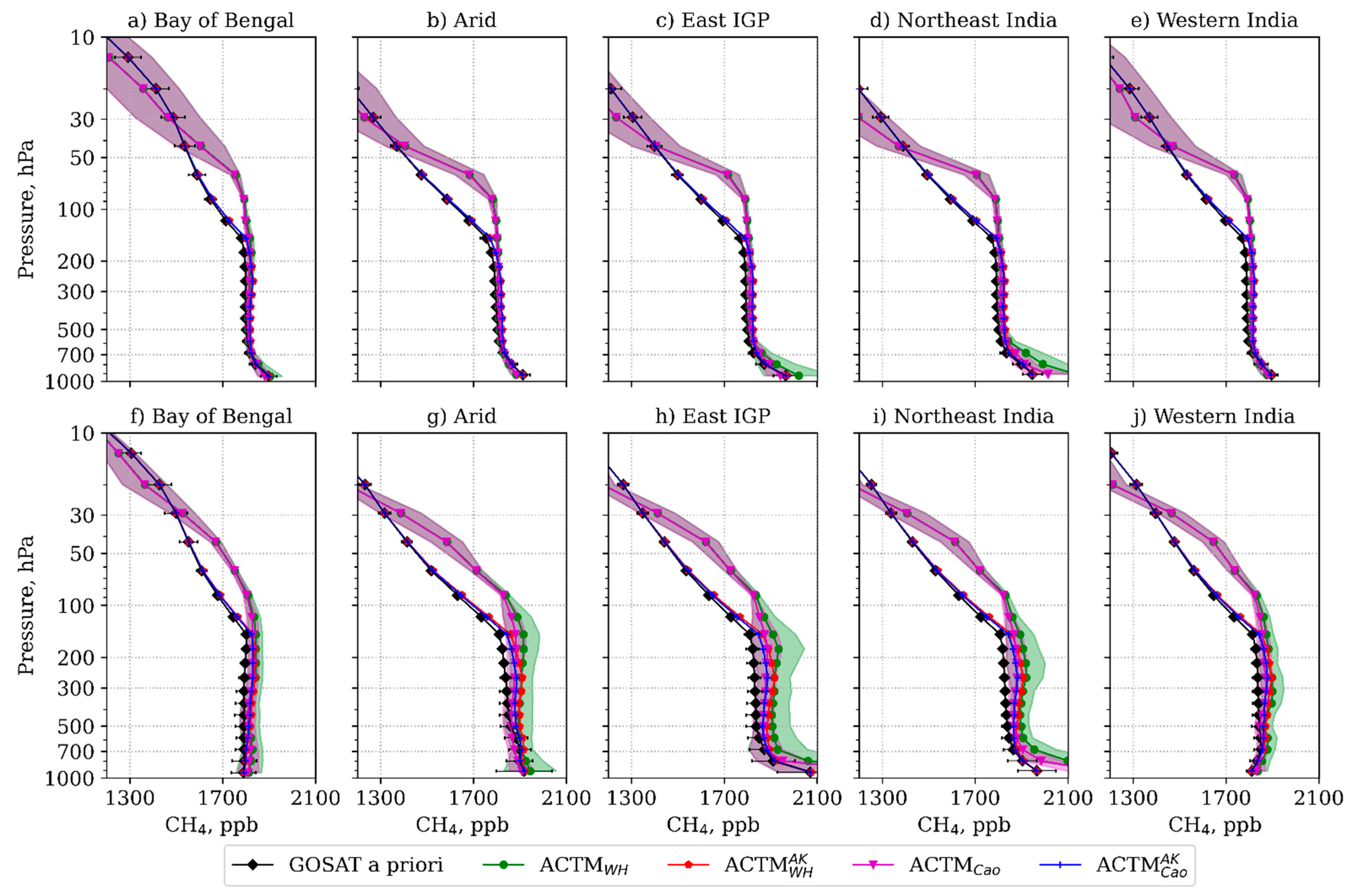
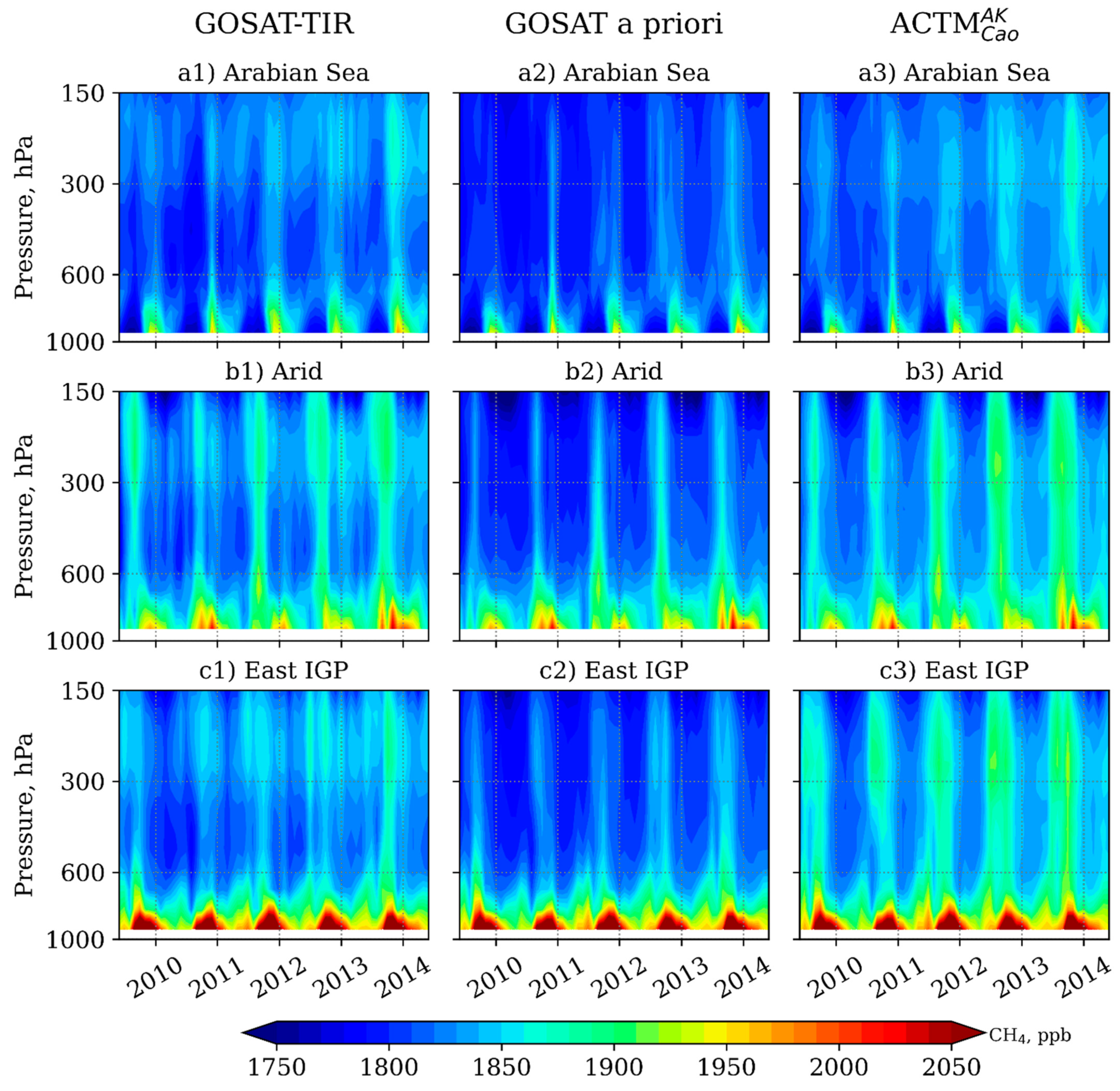
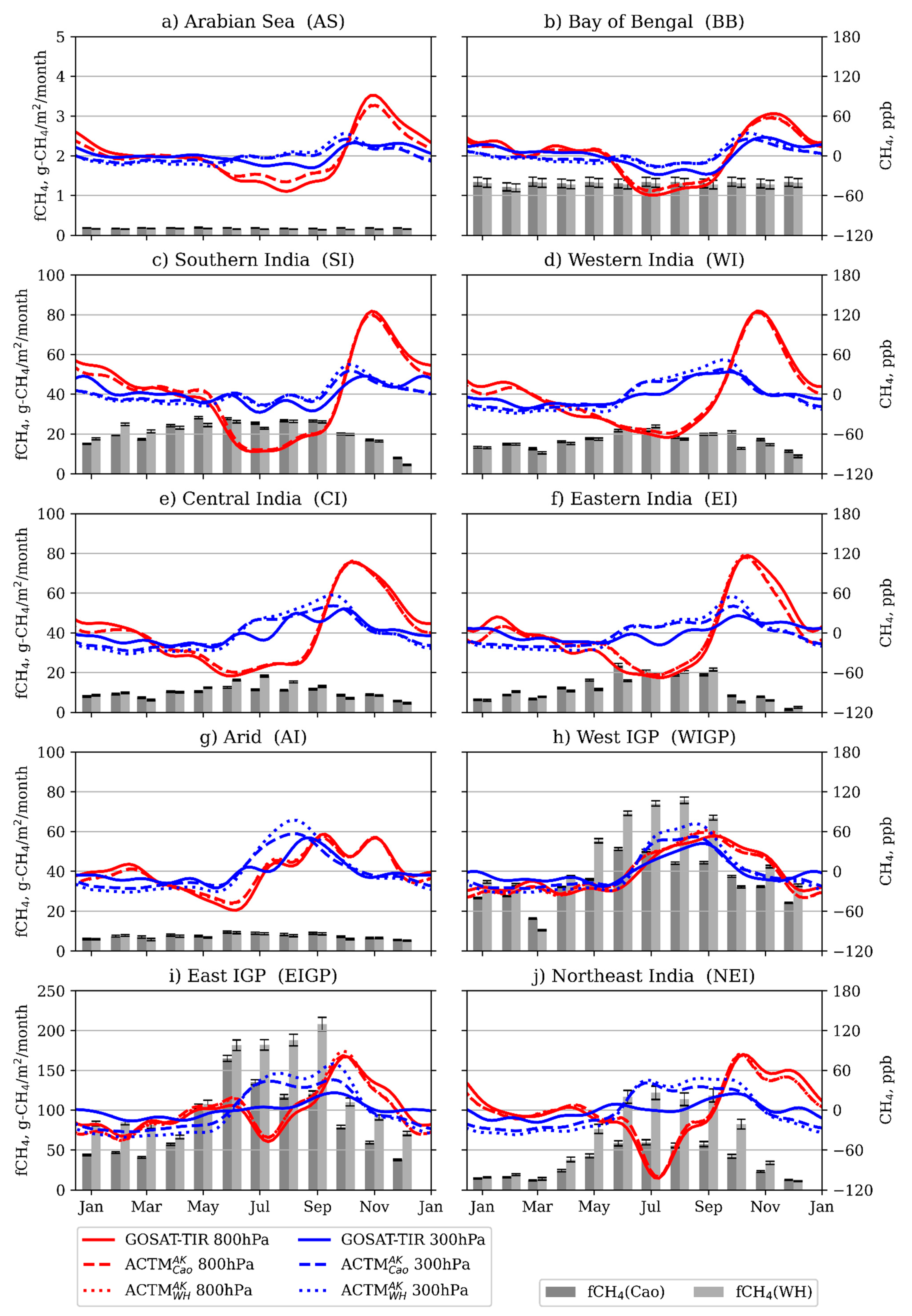

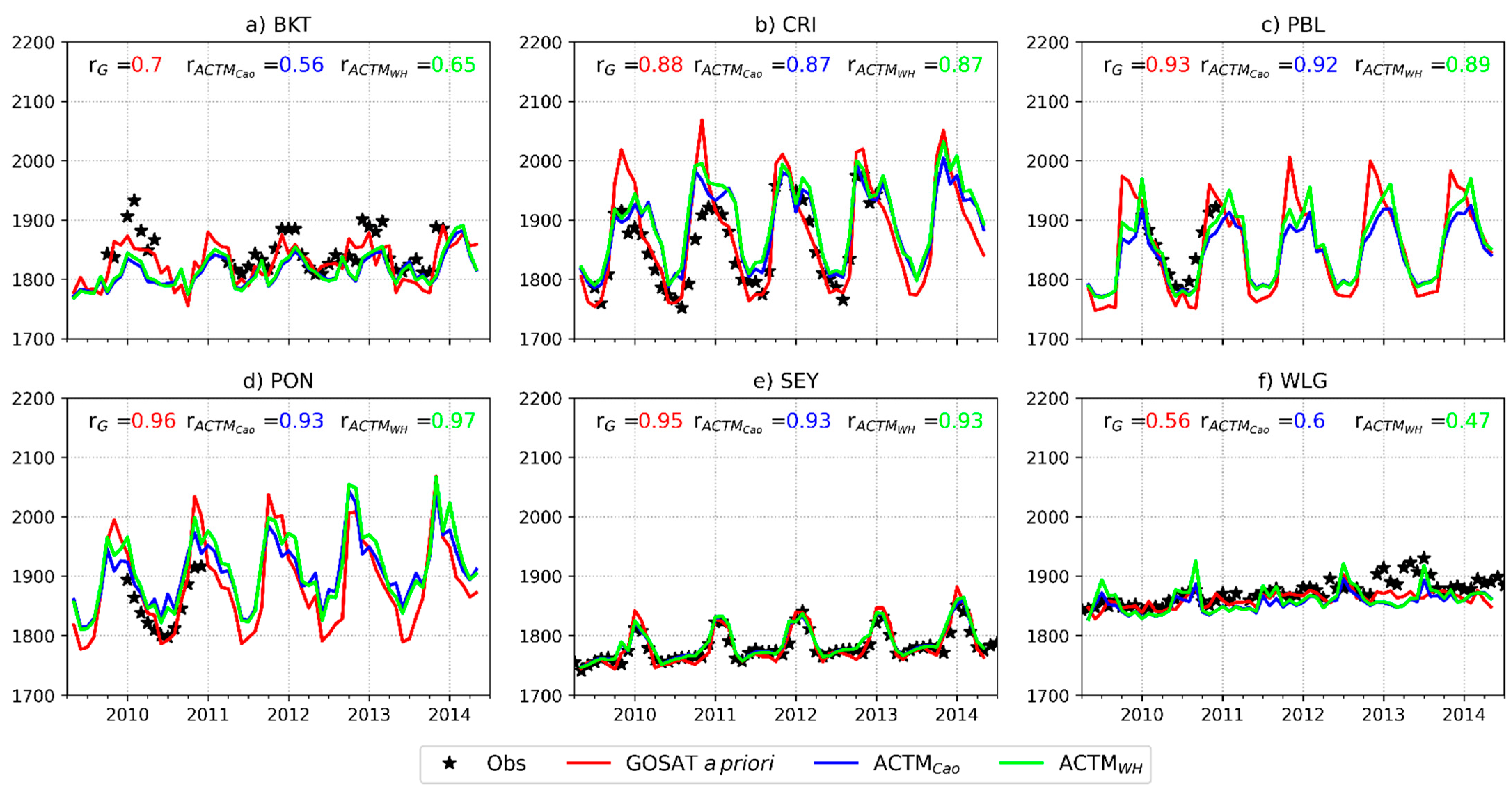
| Regions | JFM | AMJ | JAS | OND | ||||
|---|---|---|---|---|---|---|---|---|
| 800 hPa | 300 hPa | 800 hPa | 300 hPa | 800 hPa | 300 hPa | 800 hPa | 300 hPa | |
| Arid | –2.4 ± 10.5 | –12.2 ± 3.6 | –42.0 ± 12.2 | –11.2 ± 10.4 | 24.7 ± 19.6 | 26.9 ± 18.0 | 19.7 ± 20.8 | –4.3 ± 4.0 |
| Arabian Sea | 2.6 ± 5.6 | –1.1 ± 1.3 | –19.9 ± 14.7 | –4.1 ± 4.7 | –39.5 ± 13.5 | –10.3 ± 8.9 | 56.4 ± 23.8 | 15.4 ± 3.9 |
| Bay of Bengal | 11.3 ± 8.2 | 8.3 ± 4.4 | –15.5 ± 26.3 | –5.8 ± 9.5 | –40.4 ± 19.6 | –21.8 ± 7.7 | 44.7 ± 15.7 | 19.2 ± 5.7 |
| Central India | –3.1 ± 17.6 | –12.9 ± 4.3 | –51.3 ± 11.6 | –13.2 ± 7.1 | –10.3 ± 50.6 | 17.6 ± 13.9 | 64.6 ± 34.5 | 8.4 ± 12.2 |
| Eastern India | 2.4 ± 14.9 | –5.8 ± 6.5 | –43.8 ± 15.4 | –10.9 ± 4.6 | –23.3 ± 50.8 | 1.8 ± 12.9 | 64.9 ± 42.7 | 14.7 ± 5.9 |
| East IGP | –25.7 ± 7.8 | –11.2 ± 4.3 | –4.7 ± 11.8 | –4.9 ± 6.4 | 5.5 ± 39.7 | 12.7 ± 9.3 | 25.2 ± 34.4 | 3.5 ± 7.5 |
| Northeast India | –3.3 ± 6.2 | –14.1 ± 2.8 | –25.8 ± 27.3 | 0.7 ± 6.0 | –28.2 ± 50.1 | 9.0 ± 10.3 | 57.2 ± 17.7 | 4.6 ± 10.1 |
| Southern India | 20.2 ± 14.2 | 3.6 ± 6.7 | –38.8 ± 34.1 | –9.0 ± 7.8 | –60.6 ± 27.2 | –14.3 ± 10.5 | 82.1 ± 29.5 | 20.4 ± 5.8 |
| Western India | 1.4 ± 15.0 | –14.4 ± 4.8 | –43.7 ± 10.3 | –11.0 ± 6.5 | –31.6 ± 37.1 | 21.2 ± 13.0 | 73.6 ± 40.8 | 4.3 ± 11.5 |
| West IGP | –24.9 ± 6.0 | –11.9 ± 2.9 | –20.2 ± 14.3 | –10.0 ± 11.3 | 42.7 ± 8.5 | 29.5 ± 9.8 | 2.7 ± 26.0 | –7.7 ± 5.3 |
Publisher’s Note: MDPI stays neutral with regard to jurisdictional claims in published maps and institutional affiliations. |
© 2021 by the authors. Licensee MDPI, Basel, Switzerland. This article is an open access article distributed under the terms and conditions of the Creative Commons Attribution (CC BY) license (https://creativecommons.org/licenses/by/4.0/).
Share and Cite
Belikov, D.A.; Saitoh, N.; Patra, P.K.; Chandra, N. GOSAT CH4 Vertical Profiles over the Indian Subcontinent: Effect of a Priori and Averaging Kernels for Climate Applications. Remote Sens. 2021, 13, 1677. https://doi.org/10.3390/rs13091677
Belikov DA, Saitoh N, Patra PK, Chandra N. GOSAT CH4 Vertical Profiles over the Indian Subcontinent: Effect of a Priori and Averaging Kernels for Climate Applications. Remote Sensing. 2021; 13(9):1677. https://doi.org/10.3390/rs13091677
Chicago/Turabian StyleBelikov, Dmitry A., Naoko Saitoh, Prabir K. Patra, and Naveen Chandra. 2021. "GOSAT CH4 Vertical Profiles over the Indian Subcontinent: Effect of a Priori and Averaging Kernels for Climate Applications" Remote Sensing 13, no. 9: 1677. https://doi.org/10.3390/rs13091677
APA StyleBelikov, D. A., Saitoh, N., Patra, P. K., & Chandra, N. (2021). GOSAT CH4 Vertical Profiles over the Indian Subcontinent: Effect of a Priori and Averaging Kernels for Climate Applications. Remote Sensing, 13(9), 1677. https://doi.org/10.3390/rs13091677








